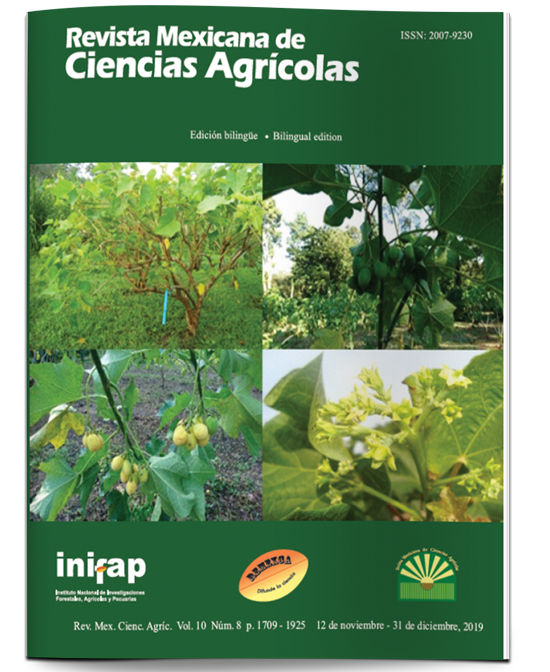Characterization of chia collections from the western region of Mexico
DOI:
https://doi.org/10.29312/remexca.v10i8.1955Keywords:
Hirsuta, Salvia hispanica, Salvia tiliifolia, diversity, fatty acidAbstract
Chia is a very valuable resource since it is the main source of unsaturated fatty acids, mainly α-linolenic, in addition to protein and fiber. In this investigation, seven collections were made in seven locations for study and comparison. Seed size were measured, thousand seed weight, volumetric weight, color, germination percentage and oil extraction for chromatography analysis. The collection of cultivated chia from Guanajuato showed greater variability in seed size and that of Roque la minor. The wild collections had the smallest seed size. The cultivated one of Guanajuato has the greater weight in seed and the wild ones the minor, the latter did not germinate, but the domesticated ones did. There were no differences in volumetric weight; however, there were differences in chromatograms (HPLC) and in physical characteristics and color variation in domesticated ones, including white seeds. This prospective research shows that the variability present in wild and cultivated chia can be used for plant breeding.
Downloads
Published
How to Cite
Issue
Section
License
The authors who publish in Revista Mexicana de Ciencias Agrícolas accept the following conditions:
In accordance with copyright laws, Revista Mexicana de Ciencias Agrícolas recognizes and respects the authors’ moral right and ownership of property rights which will be transferred to the journal for dissemination in open access. Invariably, all the authors have to sign a letter of transfer of property rights and of originality of the article to Instituto Nacional de Investigaciones Forestales, Agrícolas y Pecuarias (INIFAP) [National Institute of Forestry, Agricultural and Livestock Research]. The author(s) must pay a fee for the reception of articles before proceeding to editorial review.
All the texts published by Revista Mexicana de Ciencias Agrícolas —with no exception— are distributed under a Creative Commons License Attribution-NonCommercial 4.0 International (CC BY-NC 4.0), which allows third parties to use the publication as long as the work’s authorship and its first publication in this journal are mentioned.
The author(s) can enter into independent and additional contractual agreements for the nonexclusive distribution of the version of the article published in Revista Mexicana de Ciencias Agrícolas (for example include it into an institutional repository or publish it in a book) as long as it is clearly and explicitly indicated that the work was published for the first time in Revista Mexicana de Ciencias Agrícolas.
For all the above, the authors shall send the Letter-transfer of Property Rights for the first publication duly filled in and signed by the author(s). This form must be sent as a PDF file to: revista_atm@yahoo.com.mx; cienciasagricola@inifap.gob.mx; remexca2017@gmail.
This work is licensed under a Creative Commons Attribution-Noncommercial 4.0 International license.



